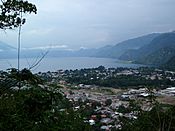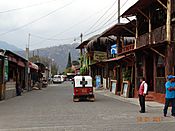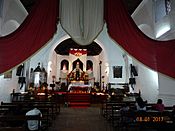Panajachel facts for kids
Quick facts for kids
Panajachel
|
|
|---|---|
|
City and municipality
|
|
 |
|
| Country | |
| Department | |
| Government | |
| • Type | municipal |
| Elevation | 1,597 m (5,240 ft) |
| Lowest elevation | 1,562 m (5,125 ft) |
| Population | |
| • Total | 11,142 |
| Time zone | UTC-6 (Central Time) |
| Country code | 502 |
| Climate | Aw |
Panajachel (pronounced pan-a-ha-CHEL), often called Pana, is a town in the highlands of southwestern Guatemala. It's less than 145 kilometers (90 miles) from Guatemala City. The town is part of the Sololá area.
Panajachel is the main town for the area around it. It sits on the northeast shore of Lake Atitlán. The town is a popular spot for tourists. Many visitors use Panajachel as a starting point to explore other towns and villages around the lake.
The name "Panajachel" comes from the Kaqchikel language. It means "place of the Matasanos." Matasanos are a type of fruit tree called white sapote.
Contents
History of Panajachel
Early History: Spanish Colony
In the 1500s, during the Spanish takeover of Guatemala, a big battle happened near the lake. The Spanish, with their Kaqchikel friends, defeated the Tz'utujils.
After the Spanish won, a group of Franciscans (a type of Catholic priest) built a church and monastery in Panajachel. They used the town to teach the local people about the Roman Catholic faith. The front of the church today is still the original one. It is seen as a beautiful example of colonial architecture in Guatemala.
Panajachel was part of a larger area called Tecpán Atitlán. In 1730, Panajachel became part of a major municipality. The Franciscans were in charge of the Catholic faith in this region. Their area, called "Province of the Most Holy Name of Jesus," had 24 convents. By 1700, Panajachel had a convent with three priests. They looked after about 1,800 people.
Daily Life and Religious Practices
Every day, there was a Catholic Mass that local leaders and their wives attended. Children aged 6 and older had religious lessons daily. These classes lasted two hours and involved memorizing church teachings. Adults went to Mass every Sunday and on holidays. After Mass, they had religious lessons in their own language.
During Lent, the friars taught the local people very carefully. They used the people's own language to help them understand. Every Friday during Lent, there was a procession. People followed the path of the Rosary all the way to the Calvary temple.
In 1754, the Franciscans had to give their churches to other priests. This was part of changes made by the Spanish government. So, when Archbishop Pedro Cortés y Larraz visited Panajachel in 1770, he called it the "San Francisco Panajachel parish."
Archaeologist Alfred P. Maudslay's Visit in 1892
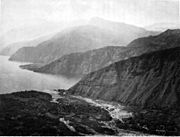
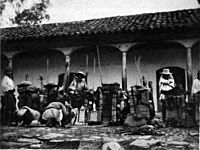
In 1892, British archaeologist Alfred Percival Maudslay and his wife, Anne Maudslay, visited Panajachel. They wrote about their trip in a book called A Glimpse at Guatemala.
Anne Maudslay described Panajachel as a "little town." It was on a rich, flat area made by a fast stream. This stream had spread out earth into a fan shape. This created a mile-long front to Lake Atitlan.
By 1892, people in Panajachel had built many irrigation canals. These canals changed the stream's path. They used them for orchards, gardens, and coffee farms. However, these channels were not enough to stop floods. Floods happened sometimes and destroyed houses.
The town itself was not very exciting to the visitors. But the area around it was amazing. There were volcanoes, mountains, and Lake Atitlan. The green forests around the lake looked very different from the bare hills near Panajachel.
Life in town seemed boring to Anne Maudslay. Especially for women, who seemed to do the same things every day. They ground corn to make tortillas and washed clothes by the stream. Only women who sold their goods in the market had a slightly different routine.
Observing a Unique Ceremony
While in Panajachel, the Maudslays saw a religious ceremony. Many pilgrims were returning from visiting Esquipulas. The pilgrims gathered in the main square that night. They built fires to cook their food. After eating, they laid out petates (native Guatemalan mats) in a line across the square.
Each person took out a small wooden box. From it, they pulled out a small Catholic saint statue. They placed the statue of the Black Christ of Esquipulas in the center. Once everything was ready, they began their ritual. They crawled from one mat to the next on their knees. They pressed their foreheads against the floor in front of each saint.
Each man did this many times. In the end, they all gathered around the Black Christ. They sang a hymn for about thirty minutes. After that, they packed their things and slept on the square's floor. Anne Maudslay wrote that even though it looked like a Catholic ritual, it was actually a Mayan one. Priests they met on their journey said they weren't sure if the local people had truly accepted the Catholic faith.
20th Century Changes
In the 1960s, many Hippies were drawn to Panajachel. But during the Guatemalan Civil War, fewer foreign visitors came. After the war ended, tourists started to return. Now, Panajachel's economy mostly relies on tourism again.
21st Century: Hurricane Stan
In October 2005, Hurricane Stan brought very heavy rains to Panajachel. A large mudslide happened, destroying about 100 homes along the river.
Places to Visit in Panajachel
Casa Cakchiquel, built in 1948, was one of the first hotels on the lake. It is said that famous people like Ernesto "Che" Guevara and Ingrid Bergman stayed there. Today, it is a Cultural Center. It has been beautifully restored. It is one of two historic buildings in Panajachel that are considered "cultural heritage" sites. The other is the central Church of Saint Francis of Assisi.
Casa Cakchiquel has a Museum & Gallery. It shows Guatemala's first historical photo museum. It has over 3000 photos from 1860 to 1970. These photos are by important photographers like Emilio and Roberto Eichenberger, Alberto G. Valdeavellano, and others.
Casa Cakchiquel is also home to Radio 5, FM99.1. This is the local radio station for the Atitlan Basin area.
Panajachel also has one of the oldest art galleries in Central America, called La Galeria. It is located down the street from Rancho Grande.
International Organizations in Panajachel
Many international non-profit organizations work in Panajachel. Some of these include:
- Porch de Salomon
- Mercado Global
- Maya Traditions Foundation
- Mayan Families
- Thirteen Threads (Oxjalul B'atz')
- Friendship Bridge
- Sharing the Dream
Gallery
Climate in Panajachel
Panajachel has a tropical climate. It is very close to a tropical savanna climate.
| Climate data for Panajachel | |||||||||||||
|---|---|---|---|---|---|---|---|---|---|---|---|---|---|
| Month | Jan | Feb | Mar | Apr | May | Jun | Jul | Aug | Sep | Oct | Nov | Dec | Year |
| Mean daily maximum °C (°F) | 25.6 (78.1) |
25.6 (78.1) |
26.6 (79.9) |
26.1 (79.0) |
25.9 (78.6) |
23.7 (74.7) |
24.8 (76.6) |
24.9 (76.8) |
24.3 (75.7) |
24.6 (76.3) |
25.2 (77.4) |
25.4 (77.7) |
25.2 (77.4) |
| Daily mean °C (°F) | 18.9 (66.0) |
18.8 (65.8) |
19.7 (67.5) |
19.8 (67.6) |
20.1 (68.2) |
19.1 (66.4) |
19.6 (67.3) |
19.5 (67.1) |
19.1 (66.4) |
19.3 (66.7) |
19.1 (66.4) |
18.7 (65.7) |
19.3 (66.8) |
| Mean daily minimum °C (°F) | 12.3 (54.1) |
12.0 (53.6) |
12.9 (55.2) |
13.6 (56.5) |
14.3 (57.7) |
14.6 (58.3) |
14.4 (57.9) |
14.1 (57.4) |
14.0 (57.2) |
14.0 (57.2) |
13.0 (55.4) |
12.1 (53.8) |
13.4 (56.2) |
| Average precipitation mm (inches) | 2 (0.1) |
15 (0.6) |
15 (0.6) |
48 (1.9) |
137 (5.4) |
355 (14.0) |
174 (6.9) |
185 (7.3) |
328 (12.9) |
182 (7.2) |
38 (1.5) |
11 (0.4) |
1,490 (58.8) |
| Source: Climate-Data.org Instituto Nacional de Sismología, Vulcanología, Meteorología e Hidrología de Guatemala |
|||||||||||||
Where is Panajachel Located?
Panajachel is located 6 kilometers (about 3.7 miles) south of Sololá. It is also 146 kilometers (about 90.7 miles) west of Guatemala City.
 |
Sololá | Sololá y Concepción |  |
|
| Lago de Atitlán | San Andrés Semetabaj | |||
| Lago de Atitlán | Santa Catarina Palopó |
See also
 In Spanish: Panajachel para niños
In Spanish: Panajachel para niños






